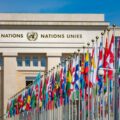Paganism in Europe: A contemporary revival unveiled
Paganism in Europe: A contemporary revival unveiled
The resurgence of paganism in Europe invites us to explore a living and evolving expression of the human quest for the sacred in the modern world.
Paganism in contemporary European culture
Is paganism experiencing a revival in contemporary Europe? Paganism is a set of ideas and beliefs connected to land and ancestry that has a deep history in European cultures. Recent references to paganism, such as the inclusion of a Green Man motif on the invitation to the coronation ceremony of King Charles III, reflect a wider resurgence of paganism in the modern world.[1]
As highlighted in an article by The Guardian, this insight is indicative of a broader trend observed in various cultural products, such as fantasy literature and cinematic genres, that are rich in pagan symbolism. Another example can be found in the frequent utilisation of pagan inspiration by British folk revival musicians.[2] Indeed, whether through the 2019 film Midsommar[3] or the royal invitation itself, it is evident that paganism is gaining prominence in European popular culture.
For Professor Linda Woodhead,[4] a British sociologist specialised in contemporary spirituality, paganism “has become incredibly mainstream, and that means it’s become incredibly diverse.”[5]
Definition and origins of paganism
Modern paganism, also called neopaganism, is defined as a set of contemporary religions drawing inspiration from the ancient pre-Christian belief systems of Europe, North Africa, and West Asia. The emergence of modern pagan religions occurred predominantly in Europe and North America during the 20th century, and collectively, they boast a substantial following, numbering at least in the hundreds of thousands, potentially extending into the low millions.[6]
Since the 4th century, Christians referred to followers of non-Abrahamic religions as Pagani (pagans). They commonly considered the religious traditions of these peoples to be founded on fundamental error, often interpreting the gods and goddesses within those traditions as demons.[7]
This artistic and cultural celebration of pre-Christian mythologies laid the foundation for modern paganism. Its roots trace back to classical mythologies of pre-Christian Greeks and Romans, along with influences from the mythologies of the Germanic people, ancient Egyptian deities, traditions like Wicca, Druidry, and goddess spirituality.[8]
The resurgence of pagan tendencies within Christian culture
Some scholars argue that the waning influence of Christian culture in the West has led to the resurgence of latent pagan tendencies that were once concealed. According to Chantal Delsol, a French philosopher, historian, and novelist, paganism never truly vanished from the Christian landscape as the Church failed to eradicate its remnants.[9] This could explain why 74,000 people in Britain identified as pagan during the 2022 census.[10]
Delsol asserts that environmentalism, with its reverence for animals, plants, and elements of nature deemed sacred, aligns with pagan thought. This represents just one facet of the various manifestations that paganism exhibits today. Despite its divergence from pre-Christian paganism (within Roman society, for instance), it signifies a “return to the veneration of sacred nature.”[11]
Pagan practices across various European nations
Stéphane François, a Professor of Political Science at the University of Mons, asserts that contemporary paganism has undergone a notable resurgence since the 1980s, leading to its recognition as an official religion in various European countries.[12]
This revival has gained notable strength in Scandinavia, where several countries share a common historical tradition and faith rooted in the legacy of the Vikings. In the subsequent lines, we aim to delve into the revival of paganism in certain Scandinavian countries, spanning from the late 20th century to the early 21st century.
The Viking religion of Ásatrú in Iceland
The Ásatrú Association of Iceland is a pagan group deeply rooted in local folklore. Devoted to celebrating the Old Norse mythology and its pantheon of deities, including Odin, Thor, and Loki, who arrived in Iceland during the Viking age, the association embraces the ancient traditions. In the year 1000, Iceland transitioned from heathenry to Christianity, succumbing to pressure from the influential Norwegian crown.[13]
However, in 1972, a visionary group of artists, led by the late sheep farmer and poet Sveinbjörn Beinteinsson, embarked on a mission to revive the old pagan faith. They founded the Ásatrú Association and in the following year successfully persuaded the Icelandic government to officially recognise it as a religion.[14]
Ásatrú has experienced remarkable growth in Iceland, emerging as one of the rapidly expanding religious communities. Over the span of just a decade, its population has quadrupled from a modest 1,275 individuals in 2009 to 4,473 in 2018.[15]
Forn Siðr: officially recognised as a religion in Denmark
Another illustrative case is the Forn Siðr, a revival of the worship of the ancient Nordic Powers from the Viking era. The Forn Siðr movement is also the name of the largest organisation within Ásatrú (literally ‘faith in the Æsir’ gods). This religious community gained official approval in Denmark, being recognised by the Danish Ministry of Religious Affairs in 2003.[16]
Forn Siðr, rooted in ancient Danish tradition, aims to reconstruct the pre-Christian religion of northern Germans, particularly the Vikings, before the Christianisation of Denmark. Based on the content of Forn Siðr’s declaration of faith, they hold belief in the same gods who once bestowed meaning and aid upon their ancestors —the Æsir–Vanir— and place their trust in them. Their faith extends to the belief that life and spirit inhabit mankind, animals, nature, and sacred places.[17]
The ancient Lithuanian faith of Romuva
Lithuania, once the last pagan nation in Europe, witnessed the majority of its remaining Baltic pagans converting to Christianity following the establishment of the Commonwealth of Poland-Lithuania in 1569. Efforts to revive the ancient faith began in the late 19th and early 20th centuries. Unfortunately, the Soviet occupation of 1940 dealt a severe blow to this revival as practitioners, often targeted due to the nationalist character of Romuva, were either deported to gulags or met with fatal consequences. Despite these challenges, the Romuva movement persists today as one of the primary contemporary pagan denominations in Lithuania, emphasising the reconstruction of a pre-Christian religion.[18] [19]
In 1992, two years after Lithuania gained independence, Romuva, seeking official recognition, registered as a religion with the government. According to the established criteria, a religion can be considered for state recognition after 25 years of registration, provided it maintains a positive standing in society. Despite meeting these conditions, Romuva was not officially recognised in 2019. The decision followed a debate where followers of the faith were accused of having affiliations with the Kremlin.[20]
Reviving ancestral threads
From the coronation ceremonies of monarchs to the pages of fantasy literature, pagan symbolism is weaving its way into the cultural fabric. The official recognition of pagan practices in various European countries reflects a growing acceptance of ancient belief systems. As we journey through Iceland, Denmark, and Lithuania, witnessing the revival of Ásatrú, Forn Siðr, and Romuva, we find stories of adaptability and endurance.
Paganism, once considered a relic, is now a diverse and mainstream force in contemporary spirituality. This revival signifies a collective effort to reconnect with ancestral roots, offering a nuanced understanding of Europe’s rich cultural heritage. The resurgence of paganism invites us to explore a living and evolving expression of the human quest for connection, meaning, and the sacred in the modern world.
Learn more about religion and society on the EARS Dashboard
Sources
[2] Dawn of the new pagans: ‘Everybody’s welcome – as long as you keep your clothes on!’
[3] Midsommar: What Inspired the Bizarre Folklore in the Film?
[4] Tradition in transition: Linda Woodhead on women’s roles in the paradoxical religion of tomorrow
[5] Dawn of the new pagans: ‘Everybody’s welcome – as long as you keep your clothes on!’
[7]Ibidem
[8] Ibidem
[9] The Emergence of a New Paganism: An Interview with Chantal Delsol
[10] Shamanism, pagans and wiccans: trends from the England and Wales census
[11] Ibidem
[12] Le néo-paganisme et la politique : une tentative de compréhension
[13] How Iceland recreated a Viking-age religion
[14] Ibidem
[15] Ibidem
[16] Forn Siðr, The Aesir and Vanir faith community in Denmark
[17] The Spirituality of Contemporary Danes – between Paganism and Secularisation
[18] Le paganisme contemporain en Lituanie – le mouvement Romuva
[19] The ancient Lithuanian religion bidding for state recognition: What next for Romuva?
[20] Ibidem






